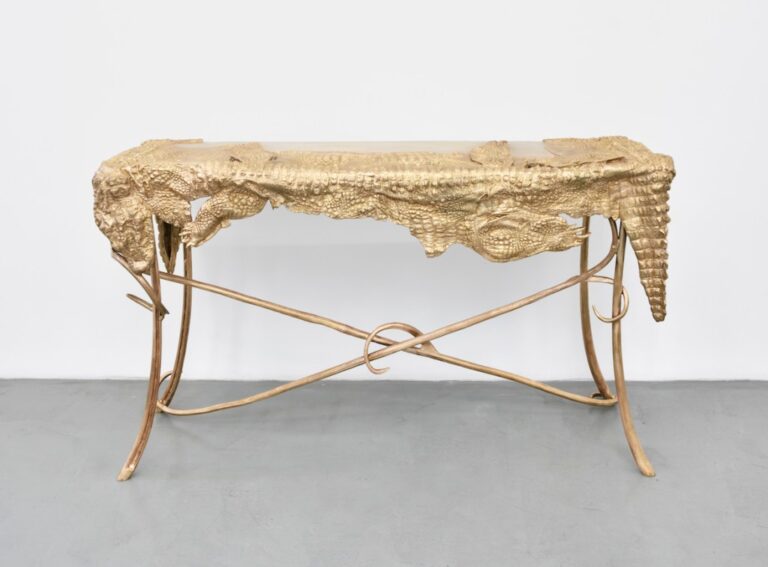In a cozy booth outside one of the six restaurants at TEFAF Maastricht, the art fair organized by the European Fine Art Foundation, BIll Rau, a New Orleans-based art, antiques and jewelry dealer, was talking about his most recent sale. The buyer said ARTnewswas considering A fisherman’s headan 1883 black lithographic pencil and crayon work by Vincent Van Gogh.
“The gentleman was trying to get me to lower the price, he said, ‘well, you know, it’s not that good’ … then the director of the Van Gogh Museum came and started talking about how good the drawing was,” Rau explained. . The man did not negotiate any more.
That’s the kind of thing that happens at TEFAF. Several dealers said that while people tend to focus on the big-money sales at Frieze or Art Basel, the Maastricht fair is where you’re most likely to find top representatives from institutions around the world.
Rau’s stand alone could be a room in the Metropolitan Museum. The highlight, which had been left on hold at noon on Friday, the second VIP day, was another Van Gogh. Head of a peasant woman in a white headdress (1884), which was priced at $5.5 million. A dynamic pastel work by Degas that was recently given its own room while on loan to the J. Paul Getty Museum, Ukrainian ballerinas (1899), was priced at around $20 million. Seven of the works that Rau brought were sold on the second VIP day.

vincent van gogh, A fisherman’s head (1883)
But TEFAF isn’t just about mega-sales. More than any other fair, TEFAF is about art history. The vast majority of participating dealers specialize in antiques, antiques or works on paper. Among the highlights of the opening day was an imperial cameo depicting Agrippa Postumus, the adopted son of the Roman emperor Augustus between 37 and 41 AD – gems presented by Galerie Chenel. Another, in the booth of antiques dealer Charles Ede, was a black terracotta amphora from around 530 BC decorated with the story of Hercules.
Ede had another stand, with art dealer Sean Kelly, who really captured the spirit of what is only possible at TEFAF. The two dealers collaborated on a booth in the fair’s recently opened Focus section, which “offers galleries a unique curatorial platform to delve deeper into the work of a single artist or concept.” Kelly and Ede took the mandate seriously.
The booth, which seems to exist in and out of time, is anchored by a selection of black and red Greek vases provided by Ede. Mexican designer Gloria Cortina used those vases as inspiration for two chairs and two tables made in black, red or white onyx, made specifically for the show. On the walls are new works by Scottish artist Callum Innes made in response to Ede’s vases and Cotina’s topographical furniture.

Sean Kelly at TEFAF Maastricht 2024, March 9-14, 2024, Maastricht, The Netherlands, MECC, Stand 461 and Focus Stand 702, Photo: Jaron James, Courtesy: Sean Kelly New York/Los Angeles.
One of Cortina’s tables, a multi-surface wonder that looks like an enlarged section of a key that could only open a preternaturally large door, sat five black flasks, footed bowls and Ede glasses. Behind it was one of Innes’ paintings, a delicate purple square. “So this vignette, abstract art, antiques and contemporary designs, all in one, and the beautiful thing is that the intention of creation is the same throughout the 3000 years represented, maybe a little more efficient now.”
In a way, this is a year of firsts for TEFAF Maastricht. After only starting to show contemporary art in recent years, the fair now has 30 percent modern and contemporary exhibitors. It is Rau’s first year at the fair and the first of its Focus section. Galerie Mitterand, also from the Focus section, exhibited for the first time in Maastricht, following its presentation last year at the iteration of the New York fair. Mitterand, though a newcomer, has had its fair share of interest largely because they represent Claude and François-Xavier Lalanne, the design duo beloved by collectors and fashionistas on both sides of the Atlantic. A highlight on the stand was the “Crocodile desk” that Claude made in 2007 for clothing designer Tom Ford, a wonderful example of Lalanne’s affinity for surrealist and naturalistic themes. Why did they come to Maastricht?
“When you do a modern and contemporary art fair, you see all the same people,” said gallery director Sébastien Carvalho. ARTnews. “This fair, people who are interested in jewels, the classics. And they come to this small town from all over the world. And all these people, it’s something in Lalanne that can talk to them.”
Carvalho’s sentiment was echoed by Adam Douglas, a senior specialist at London-based rare book dealer Peter Harrington. “You see a lot of the same people at book fairs,” Douglas said ARTnew. “It’s always nice to be in an environment where there are a lot of different options. It keeps the interest aroused and the mind fresh.”
Among the treasures on its stand was the first edition of what the gallery called “the world’s first modern atlas.” Based on the maps first compiled by Ptolemy, this first edition of 27 maps is supplemented by 20 “new” maps based on contemporary explorations of the time. The book was published in 1513, which means that those “new” maps contain some of the first printed maps of America. The source of the new world maps?
“It was probably Christopher Columbus. It could have been Vespucci, but it was much more likely Columbus,” Douglas said, pointing to a sharply defined Hispaniola at the far left of the map.
The map of more than 500 years was covered with the regions, countries and cultures represented at the fair. It served as neat shorthand for TEFAF, which seems to recognize that the diversity of exhibitors, guests and works is the fair’s greatest strength.


